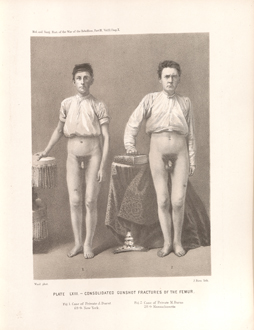Title: Burns, M.
Source text: The Medical and Surgical History of the War of the Rebellion. (1861-65.), Part 3, Volume 2 (Washington, DC: Government Printing Office, 1883), 195-196.
Civil War Washington ID: med.d2e9414
TEI/XML: med.d2e9414.xml
CASE 400.—Private M. Burns, Co. B, 28th Massachusetts, aged 22 years, was wounded at Hatcher's Run, March 25, 1865. Surgeon F. M. Hammond, 126th New York, noted his entrance into the field hospital of the 1st division, Second Corps, with "shot wound of left thigh." The wounded man reached Washington April 3d, and was admitted to the Armory Square Hospital, whence Acting Assistant Surgeon G. K. Smith reported the following history: "The missile, a minié ball, entered the anterior portion of the thigh at the junction of the middle and lower thirds, and, passing horizontally backward, fractured the femur and made its exit posteriorly. The constitutional disturbance resulting from the injury was very slight, the discharge of pus from the wound amounting to only about half an ounce in twenty-four hours. The limb was shortened two inches. It was placed on a mattrass, between two sand bags, and extension was applied with a sixteen pound weight. Muriated tincture of iron was ordered; but no stimulants were given. By April 15th, the discharge amounted to only one drachm daily, and the limb was shortened only one and a quarter inches. On May 11th, believing the fragments to be firmly united, I allowed the extension to be removed and the patient to ride on the invalid chair, and, on measuring the limb, I found that it was still shortened three-quarters of an inch. I reapplied the weight; but this contraction could not be overcome by any amount of extension that the patient could bear. He was now kept in bed until June 9th, at which time the fragments had firmly united and he commenced walking on crutches. No fragments of bone were ever removed from the limb." The patient was transferred to the Readville Hospital July 5th, and subsequently to Dale Hospital, Worcester, where he was discharged and pensioned August 28, 1865, Surgeon C. N. Chamberlain, U. S. V., certifying to "fracture of femur, with moderate deformity and shortening and slight contraction of the flexors of the thigh." The pensioner enlisted in the 43d Infantry on August 21, 1867, and was again discharged June 10, 1869. Examiner I. F. Galloupe, of Lynn, Massachusetts, certified, in 1869: "A musket ball passed through the left thigh, fracturing the femur. The wound is healed and the bone appears to be sound. The limb is shortened and he walks slow and with difficulty," etc. In June, 1874, the same Examiner reported: "In walking he does not touch the heel, but rests on the forward part of the foot, thus making locomotion slow and fatiguing. The limb is painful when much used and in cold weather. The femur is enlarged and the foot is swollen." The pensioner was paid June 4, 1879. FIG. 2 of PLATE LXIII, opp. p. 196, represents a copy of a photograph of the patient taken at the Army Medical Museum on June 25, 1865 (Surg. Phot. Series, No. 47, A. M. M.).
